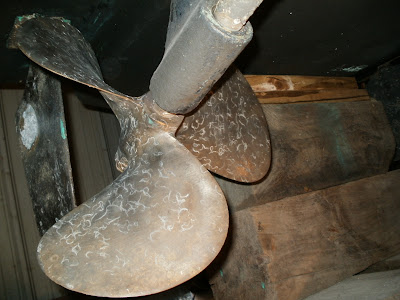The river is at about 9-ft. right now and the Travel-lift is ready to launch boats, once the water recedes about 5-feet.
A couple of boats made it in earlier last week but they won't be going anyplace soon. No big deal. It happens almost every year.
According to our list, today was the day that we'd complete the packing of the stuffing boxes. As noted last week, we got the starboard glad nut free using some spray stuff recommended by a friend in the yard. Today, we tried removing the port gland nut with a big wrench and it wouldn't budge. Then we sprayed it with the same spray-on product that we had used on the starboard side and the gland nut backed out with just a push on the wrench. We're not usually fans of anything in a can that promises to reverse the effects of physics, but we are sold on CRC Freeze-Off. If you have something rust-bound or just corroded in place, Freeze-Off really works.
It is necessary to read and follow the directions, something we rarely do, figuring that our vast life experience will trump anything that is printed on the side of a can. In this case it says to spray Freeze-Off on for 20 seconds or more, then wait 5 minutes before trying to remove the bolt, nut or whatever it is. We're glad we followed the directions because Freeze-Off worked perfectly.
If the CRC marketing department sees this post, we'll gladly accept a case of your product in exchange for this glowing endorsement.
But back to the bilge and the dreaded stuffing boxes. We tried 1/4-inch packing material on the port side but it wouldn't fit between the shaft and the packing gland. We then tried 3/16-inch and it did fit. Here's what the packing material looks like.
We cut it to length by wrapping it around the shaft and using a utility knife to cut it. The piece you see on the left in the photo is the right length. Here's what the first piece looked like as we pushed it into the gland nut.
We felt pretty good with the first ring in place so we added a second, taking care to offset the ends so they didn't line up. The second ring went in OK, but we couldn't get the glad nut to go far enough down the shaft to catch the threads on the stuffing box. So, we removed the second ring and then tightened the glad nut as much as we could to compress the first ring of packing. That worked and we were then able to add a second ring. There was no way a third ring of 3/16-inch packing was going to fit so we stopped there, leaving the gland nut hand tight. We'll run the engine in gear at the dock for a while once we're in the water and adjust the tension on the gland nut to get a small drip.
Once that was done, we stuck our Shop Vac into the bilge and sucked up all the debris that you can see in the photos. Lots of junk came out. We also cleared all the limber holes between the stringers. Amazing how much material collects down there.
The stuffing boxes and a lot of the other work we did during the winter wasn't fun. The starboard stuffing box today took 3-1/2 hours, laying between the engines and working with only our left arm. The port side took 50 minutes, using only our right arm. But, there's another way to look at it. Where else could you get such great exercise and end of with a very enjoyable boat?
Sunday's weather was beautiful and the boat yard was crowded with cars, trucks, a few motorcycles and an absolutely magnificent bright green 1940's Studebaker stake truck, owned by Bob Belling who was there working on this 33 ft. Egg Harbor. Bob's a professional Studebaker restorer and any car or truck in his fleet always gets other boaters' attention.
We're getting down to the end of our long boat list. We painted the few spots on the bottom where the bottom paint had chipped off leaving the barrier coat exposed, hosed some of the loose dirt off the cabin and deck and cleaned the boot top. We also fired up the chartplotter, radio and radar and even put a course into the chartplotter for Old Saybrook to New London. We can certainly find our way without the aid of the chartplotter but it did serve to remind us how to put a new course in. Besides, it's fun to sit up on the bridge and think about actually floating again.
Then, after six months of bringing tools and supplies down to the boat, it was time to begin taking things off so Frances can do some cleaning. For most of the winter, every horizontal surface in the salon was covered with tools. Now, it's beginning to look like a pleasure boat again rather than a workshop.
We're hoping that the Connecticut River will continue to behave. The guys at the boat yard have to put in quite a few docks before they start launching boats for real. We're still hoping to get back in the water during the week of May 9.































